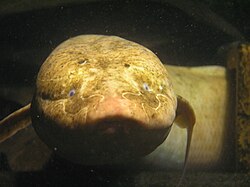Lepidosireniformes
| Lepidosirenidae Temporal range: Early Devonian–Holocene, 400 - 0 Mya |
|
|---|---|
 |
|
| Protopterus | |
| Scientific classification | |
| Kingdom: | Animalia |
| Phylum: | Chordata |
| Class: | Sarcopterygii |
| Subclass: | Dipnoi |
| Order: |
Lepidosireniformes L. S. Berg (No date given, per Fowler, 1947) |
| Families | |
Lepidosireniformes are an order of lungfish containing the families Lepidosirenidae (the South American lungfish) and Protopteridae (the African lungfish). Both of the two families are monogeneric, and the sole genus of the family Lepidosirenidae is also monospecific.
Their closest living relatives are of the order Ceratodontiformes, or the Australian lungfish; they are believed to have diverged from the other order approx. 400 MYA. The Lepidosireniformes are more closely related to the Australian lungfish and its relatives than most orders of fossil lungfish. They are known from as early as the Early Devonian. Fossil ancestors of the order have been located in Cretaceous Africa and South America for the Protopteridae and Lepidosirenidae, respectively.
All lungfish of the order can and often do estivate (with the exception of the Spotted African lungfish, which can but rarely does so). As well, the order is composed entirely of obligatory air-breathers; only the Australian lungfish has functioning gills in the adult members of the species whilst members of this order only have lungs in the larvae. The lungfish also all have generally small scales and two lungs as opposed to the Australian lungfish's single lung.
...
Wikipedia
